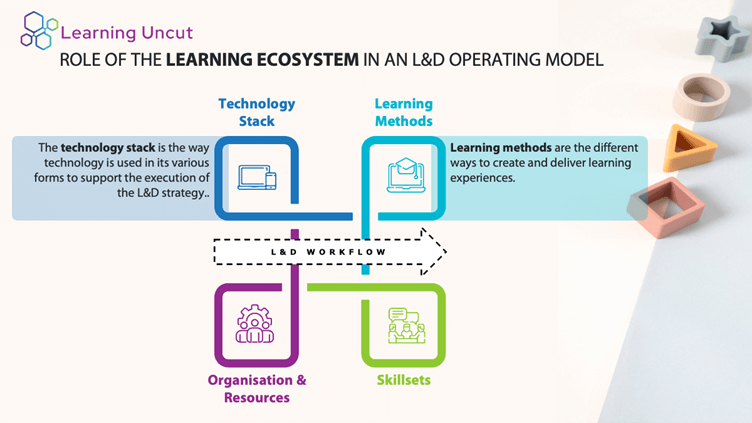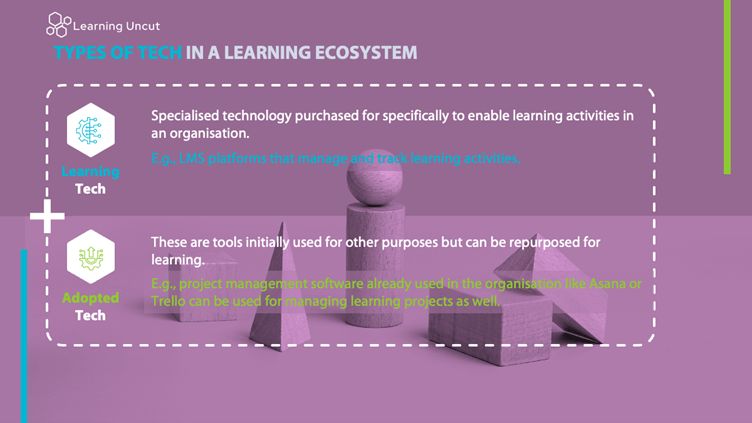In the ever-changing world of Learning & Development, the Learning Uncut approach to an L&D Operating Model is pivotal. This comprehensive framework doesn’t just outline how we operate and deliver value but also ensures that our activities and resources are in sync with our strategic goals. It’s a blueprint for enhancing performance, innovating the learning experience, and effectively managing risk. Our model is built on five key elements, each seamlessly integrated to support our overarching strategy and action plans.
Innovative Strategies for Building a Learning Ecosystem: Blending Methods and Tech
The cornerstone of our Operating Model is the development of a Learning Ecosystem. This ecosystem comes together with carefully deliberated Learning Methods and cutting-edge Learning Technology.

Integrating Learning Methods and Technology
Our approach to a learning ecosystem is two-fold:
- Learning Methods are the varied approaches we adopt to create and deliver learning experiences. Chosen based on our learning strategy and organisational maturity, these methods are as dynamic as they are diverse.
- Learning Technology is the backbone that supports and enhances our methods. It involves using various digital tools, systems, and platforms to bring our L&D strategy to life.
For instance, at the organisational level, we might choose to implement:
- Case Study Analysis and Discussions: These encourage practical understanding and application of theoretical concepts.
- Peer Learning Sessions: These sessions are designed to foster knowledge sharing and collaborative learning among employees.
- Skill-based Workshops: Focused on developing specific competencies relevant to different job roles.
To support the learning methods, we might use:
- Digital Collaboration Tools: Platforms such as Microsoft Teams or Zoom are essential for conducting case study discussions and peer learning sessions, especially in a remote or hybrid work environment. They provide features like breakout rooms, screen sharing, and interactive whiteboards to facilitate an engaging learning experience.
- Learning Management Systems (LMS): An LMS like Moodle or CornerStone can host skill-based workshops, offering a structured environment where employees can be scheduled, can access workshop materials, engage in discussions, and complete assessments.
- Content Creation Software: Tools such as MS Office can be used for developing interactive and engaging learning content for Peer Learning or Skill-based Workshops.
Commitment to Continuous Learning and Adaptation
This integrated approach means our Ecosystem is not only effective but also adaptable. Our integrated approach ensures that every learning method is effectively complemented by the right technology, enhancing the overall learning experience and driving us towards our strategic learning objectives. We continuously assess and evolve our methods and technologies. An example of this is the addition of AI to the Learning Ecosystem.
Strategies for a Cost-Effective Learning Ecosystem in a Modern Economy
In our quest for a cost-effective Learning Ecosystem, we focus on maximising existing assets. In a cost-conscious economy, this approach is more relevant than ever. It’s not just about acquiring new technologies; it’s about optimising what we already have.
- We heavily leverage 2 of the 3 types of tech that make up the learning technology landscape in an organisation (according to Redthread).

- Optimising Existing Technologies: We thoroughly assess and maximise the potential of our existing tech. For instance, many organisations underutilise platforms like SharePoint. Beyond file storage, SharePoint can be utilised for creating collaborative learning spaces and building internal knowledge bases.
- Skill and Tech Gap Analysis: By evaluating how current technologies are used, we can identify both employee skill gaps and limitations in our current tech that might necessitate additional work.
Learning Uncut’s Principles for a commercially sound Learning Ecosystem focus on creating a Learning Ecosystem that’s not just impactful but also mindful of costs. These principles are key to developing a learning strategy that aligns with our organisational goals and the broader economic landscape:
- Align with Learning strategy: Every technology and method should enable our overarching learning strategy.
- Real Needs vs. Market Trends: Critically differentiate between genuine organisational needs and fleeting technology trends.
- Optimisation Before Expansion: Explore the full range of functionalities of existing technologies before investing in new tools.
- Value Analysis: Evaluate potential new technologies to ensure that any investment offers real value to our learning ecosystem.
- Upgrade and Customise Existing Tools: Explore opportunities to upgrade and customise existing tools to better meet our evolving needs before investing in new solutions.
- Develop & Train Users: Develop and train employees to ensure they can use existing technologies effectively.
- Regular Review: Regularly review the ecosystem to ensure it remains efficient, relevant, and aligned with our needs.
In conclusion, our journey in L&D involves thoughtful innovation and strategic adaptation. We invite you to join us in embracing these principles and practices as we navigate the exciting path of learning and development in today’s dynamic world.


